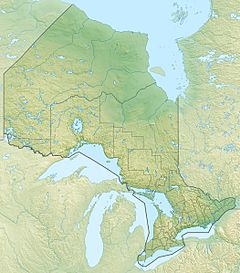Ste.-Thérèse Creek facts for kids
Quick facts for kids Ste.-Thérèse Creek |
|
|---|---|
|
Location of the mouth of Ste.-Thérèse Creek in Ontario
|
|
| Other name(s) | ruisseau Ste-Thérèse |
| Country | Canada |
| Province | Ontario |
| District | Cochrane |
| Municipality or Part |
|
| Physical characteristics | |
| Main source | Unnamed marsh Hearst 249 m (817 ft) 49°43′00″N 83°43′35″W / 49.71667°N 83.72639°W |
| River mouth | Lac Ste. Thérèse Casgrain Township 236 m (774 ft) 49°47′42″N 83°39′15″W / 49.79500°N 83.65417°W |
| Basin features | |
| River system | Moose River drainage basin |
Ste.-Thérèse Creek (also called Ste-Thérèse Creek or in French, ruisseau Ste-Thérèse) is a small stream, like a mini-river. It flows through the town of Hearst in northeastern Ontario, Canada. It is part of a larger water system called the Moose River drainage basin. This means all the rain and snow that falls in this area eventually flows into the Moose River. Ste.-Thérèse Creek is a smaller stream that flows into a lake called Lac Ste. Thérèse.
Contents
Where Does Ste.-Thérèse Creek Begin?
The creek starts in a marsh, which is a wet, grassy area. This marsh is located in the geographic area of Hanlan Township, within the town of Hearst. From its starting point, the creek begins its journey.
The Creek's Journey Through Ontario
After leaving Hearst, the creek flows towards the northeast. It then enters a part of Cochrane District that is not organized into towns or cities. This area is known as the Unorganized North Part. The creek continues its northeast path.
Reaching Lac Ste. Thérèse
The creek then moves into another geographic area called Casgrain Township. Here, it turns north, making a loop that goes east and then back west. It flows under Ontario Highway 583. Finally, Ste.-Thérèse Creek reaches its end at Lac Ste. Thérèse, a lake located near the community of Lac-Sainte-Thérèse.
How Water Leaves Lac Ste. Thérèse
The water from Lac Ste. Thérèse doesn't just stop there. It flows out through a narrow passage called the Pivabiska Narrows. This water then enters Lac Pivabiska. From there, it continues its journey through the Pivabiska River. The Pivabiska River then joins the Missinaibi River. Finally, the Missinaibi River flows into the Moose River, which eventually empties into James Bay.


